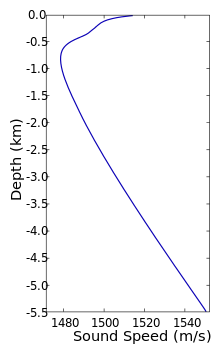
The SOFAR channel (short for sound fixing and ranging channel), or deep sound channel (DSC),[1] is a horizontal layer of water in the ocean at which depth the speed of sound is at its minimum. The SOFAR channel acts as a waveguide for sound, and low frequency sound waves within the channel may travel thousands of miles before dissipating. An example was reception of coded signals generated by the US Navy-chartered ocean surveillance vessel Cory Chouest off Heard Island, located in the southern Indian Ocean (between Africa, Australia and Antarctica), by hydrophones in portions of all five major ocean basins and as distant as the North Atlantic and North Pacific.[2][3][4][note 1]
This phenomenon is an important factor in ocean surveillance.[5][6][7] The deep sound channel was discovered and described independently by Maurice Ewing and J. Lamar Worzel at Columbia University and Leonid Brekhovskikh at the Lebedev Physics Institute in the 1940s.[8][9] In testing the concept in 1944 Ewing and Worzel hung a hydrophone from Saluda, a sailing vessel assigned to the Underwater Sound Laboratory, with a second ship setting off explosive charges up to 900 nmi (1,000 mi; 1,700 km) away.[10][11]
- ^ Navy Supplement to the DOD Dictionary of Military and Associated Terms (PDF). Department Of The Navy. June 2012. Archived (PDF) from the original on April 15, 2021. Retrieved 23 October 2021.
- ^ Munk, Walter H.; Spindel, Robert C.; Baggeroer, Arthur; Birdsall, Theodore G. (20 May 1994). "The Heard Island Feasibility Test" (PDF). Journal of the Acoustical Society of America. 96 (4). Acoustical Society of America: 2330–2342. Bibcode:1994ASAJ...96.2330M. doi:10.1121/1.410105. Retrieved 26 September 2020.
- ^ Palmer, D.R.; Georges, T.M.; Wilson, J.J.; Weiner, L.D.; Paisley, J.A.; et al. (October 1994) [24 March 1992]. "Reception at Ascension of the Heard Island Feasibility Test transmissions". Journal of the Acoustical Society of America. 96 (4): 2432–2440. doi:10.1121/1.411317. Archived from the original on 2018-04-19.
- ^ Military Sealift Command (2008). "MSC 2008 in Review — Ocean Surveillance Ships". Military Sealift Command. Archived from the original on 10 February 2018. Retrieved 28 September 2020.
- ^ Cone, Bruce E. (1 July 1976). The United States Air Force Eastern Test Range — Range Instrumentation Handbook (PDF). Patrick Air Force Base, Florida: Eastern Test Range, Directorate of Range Operations. p. 1-1. Archived (PDF) from the original on February 27, 2021. Retrieved 12 September 2020.
- ^ De Geer, Lars-Erik; Wright, Christopher (September 22, 2019). "From Sheep to Sound Waves, the Data Confirms a Nuclear Test". Foreign Policy. Washington, DC: FP Group, Graham Holdings Company. Retrieved 23 September 2020.
- ^ "Integrated Undersea Surveillance System (IUSS) History 1950 - 2010". IUSS/CAESAR Alumni Association. Retrieved 25 September 2020.
- ^ "William Maurice Ewing (1906-1974)" (PDF). Washington, D.C.: National Academy of Sciences. 1980: 136–137. Retrieved 25 September 2020.
{{cite journal}}: Cite journal requires|journal=(help) - ^ Kaharl, Victoria (March 1999). "Sounding Out the Ocean's Secrets" (PDF). Washington, D.C.: National Academy of Sciences. Retrieved 25 September 2020.
{{cite journal}}: Cite journal requires|journal=(help) - ^ "History of the SOFAR Channel". University of Rhode Island and Inner Space Center. 2020. Retrieved 26 September 2020.
- ^ Naval History And Heritage Command. "Saluda". Dictionary of American Naval Fighting Ships. Naval History And Heritage Command. Retrieved 26 September 2020.
Cite error: There are <ref group=note> tags on this page, but the references will not show without a {{reflist|group=note}} template (see the help page).